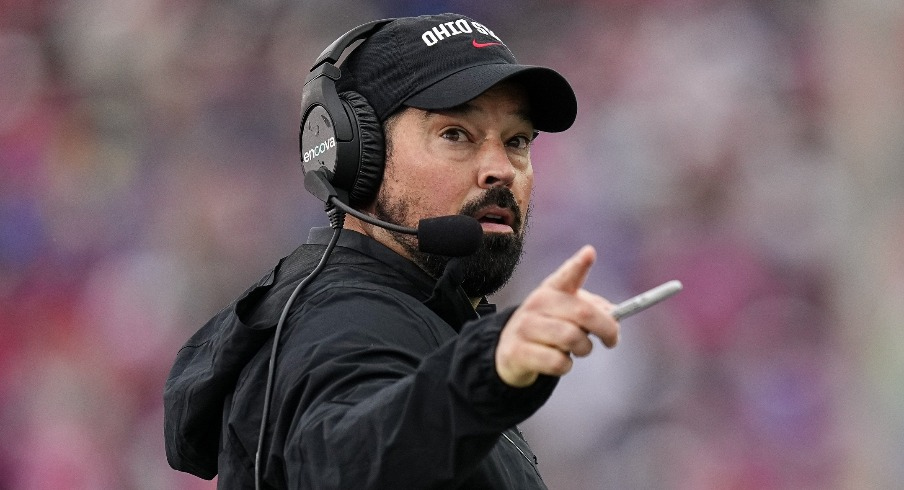Ohio State and the rest of the teams in the Big Ten will play a nine-game conference schedule for the eighth straight year in 2023.
That’s all Ryan Day has ever known since entering the scarlet and gray program in 2017. In fact, the nine-game regular-season slate of in-league opponents went into effect in the Big Ten the year prior. The Big 12 began playing nine conference games in 2011, and the Pac-12 – then still the Pac-10 – did so all the way back in 2006.
The SEC, however, still isn’t quite there. While many thought the conference could (or should) add another league game to its schedule for the past two offseasons, the SEC is sticking with eight games through at least 2024 – the first year Texas and Oklahoma will be a part of the conference, as well as the first year of the expanded 12-team College Football Playoff. According to a Sports Illustrated report, only five SEC teams (LSU, Texas A&M, Georgia, Florida and Missouri) voted in favor of the nine-game format during the conference’s annual spring meetings, although change is possible in 2025 and beyond.
"We have been engaged in planning for the entry of Oklahoma and Texas into the SEC since the summer of 2021, but the change of the membership date from 2025 to 2024 creates scheduling complexities that can better be managed with a one-year schedule," SEC commissioner Greg Sankey said in a statement.
Day, whose Buckeyes will continue to play a nine-game conference schedule when the Big Ten adds two new teams of its own (USC and UCLA) in 2024, believes there should be uniformity across college football’s conference game requirements. In an interview on the Joel Klatt Show, Day even mentioned a 10-game league slate as an intriguing possibility in the future.
Due to the expansion of the playoff, Day thinks the sheer quantity of wins a team can muster or won’t mean as much as its quality of victories. With one regular-season loss no longer threatening to preclude a program from postseason contention come 2024, a shiny record won’t be the sole determining factor in discerning which teams have a chance to win it all at the end of the year.
“I just think it should be consistent. I do think that having nine games is great. The quality wins will be important as we move into the playoff era,” Day said. “I think that certain wins are gonna mean a lot more. It won’t look like March Madness when it comes to that, but having quality wins will be important, not just the number of wins or losses. Because I think, to your point now, you can put your schedule in such a way that you can set it up so you get a certain number of wins. And at the end of the year, that looks a lot better than maybe a one- or two-loss team, and they may be better in the end.
“And I think the idea is to get the best teams into the playoffs, and so having a nine-game conference schedule or maybe even down the road a 10-game conference schedule is a great thing. As long as it's consistent across the board, I think that’s what’s critical.”
Day said the new CFP model will “completely change” how college coaches approach their season, and cited Ohio State’s 2022 season opener as an example. Had the Buckeyes lost their Week 1 matchup with Notre Dame this past year, Day said, “Maybe we don’t get into the playoffs.”
“You’re ramped up because that game is critically important. … One or two games could ruin your entire season right now, the way we have it set up," Day said.
While Big Ten teams will still play the same number of conference games in 2024, they will have to deal with a different major change in terms of schedule format. The Big Ten is set to drop its divisional structure after the 2023 season, which means the two best teams in the entire league will face off in the conference title game rather than the top programs in the East and West Divisions.
The Big Ten announced schedules for the 2024 and 2025 seasons last month, with each team (other than Penn State) having at least one annual protected rivalry game. Aside from Ohio State’s yearly Michigan matchup, the Buckeyes will play all of the other 15 teams in the conference at least once every two years.
But whether it’s the Big Ten or any other conference looking to adopt a similar model down the line, Day said maintaining a fair balance in terms of competition from one team’s schedule to the next is paramount.
“If you go away from divisions, you have to really make sure that it’s equitable across the board,” Day said. “How do you do that? Do you use the historical data or do you try to find trends based off of how a team is doing, what they’ve done the last couple years? I think that’s the trick. We certainly know in the NFL how they do it.”
Day pushed back on the notion that the best team in a conference should receive the toughest league schedule and also said schedules shouldn’t be made too far in advance due to the rapidly changing nature of the sport. But it sounds like Day is on the same page with the Big Ten as it pertains to the latest modifications to the scheduling format.
“I think that we should look at them in at least two-year windows, not down the road. Because things change,” Day said. “Staffs change, trends change, recruiting changes things. So I think we need to continually look at that. There’s still gonna be rivalries in place, protected opponents where you’re gonna have certain rivals that you play and then a rotating schedule, and I think that’s healthy for the conference. But I think you gotta look at all those types of things and figure out (what is best).”
It’s no secret that changes to the college football landscape have become increasingly frequent in the past several years. Amid all of them, Day thinks consistency – both within conferences and across them – is the best way to keep things fair.


